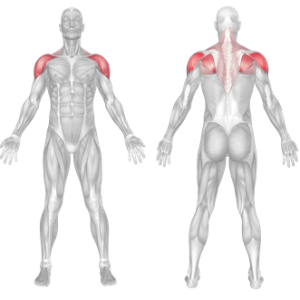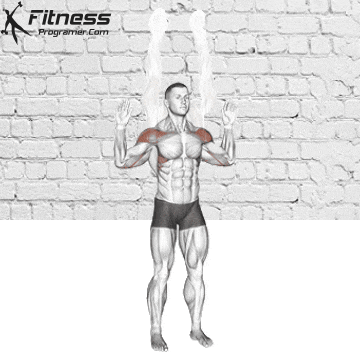Wall Slides
Wall slides are a commonly prescribed exercise for improving shoulder mobility and stability. They help to strengthen the muscles around the shoulder joint and enhance the range of motion. They can be beneficial for individuals with various shoulder issues, such as shoulder impingement, rotator cuff injuries, or general stiffness.
How to do:
- Stand with your back against a wall, feet about hip-width apart.
- Position your arms against the wall with your elbows bent at a 90-degree angle, palms facing forward.
- Gently slide your arms up the wall, maintaining contact between your hands, elbows, and the wall.
- As you slide your arms upward, aim to keep your shoulder blades squeezed together and down.
- Go as far as you can comfortably without pain or excessive strain.
- Pause for a moment at the top, then slowly slide your arms back down to the starting position.
- Repeat the movement for the desired number of repetitions.
Here are a few tips to keep in mind:
- Focus on maintaining good posture throughout the exercise. Keep your head, upper back, and buttocks in contact with the wall.
- Start with a small range of motion and gradually increase it as your shoulder mobility improves.
- Pay attention to any pain or discomfort during the exercise. If you experience pain, decrease the range of motion or consult a healthcare professional.
- Perform the exercise in a controlled manner, avoiding any sudden or jerky movements.
- It’s always a good idea to warm up your shoulder joints with some light movements or stretches before performing shoulder wall slides.
Wall Slides Benefits
Improved shoulder mobility: Wall slides help to increase the range of motion in your shoulder joints. By sliding your arms along the wall, you gently stretch and mobilize the muscles, tendons, and ligaments surrounding the shoulder complex.
Enhanced shoulder stability: The exercise targets the muscles that provide stability to the shoulder joint, including the rotator cuff muscles and scapular stabilizers. Strengthening these muscles can help improve shoulder stability and reduce the risk of injuries, such as shoulder dislocations or impingements.
Corrects postural imbalances: Shoulder wall slides encourage proper alignment and posture by promoting scapular retraction and depression. This can help counteract the effects of rounded shoulders or forward head posture that are common due to sedentary lifestyles or desk-bound work.
Rehabilitation and injury prevention: Wall slides are often recommended during shoulder rehabilitation programs for various conditions, including rotator cuff injuries, shoulder impingement, and post-surgical recovery. The controlled movement and gentle stretching can aid in the healing process and prevent further injury.
Easy and accessible exercise: Shoulder wall slides can be performed almost anywhere, requiring only a wall and your own body weight. They don’t require any specialized equipment, making them accessible to individuals of different fitness levels and abilities.
Remember, the benefits of shoulder wall slides can vary depending on individual factors and any underlying conditions. It’s always a good idea to consult with a healthcare professional or a qualified physical therapist to ensure the exercise is suitable for your specific needs and to receive personalized guidance.
Wall Slides – Muscles Worked


